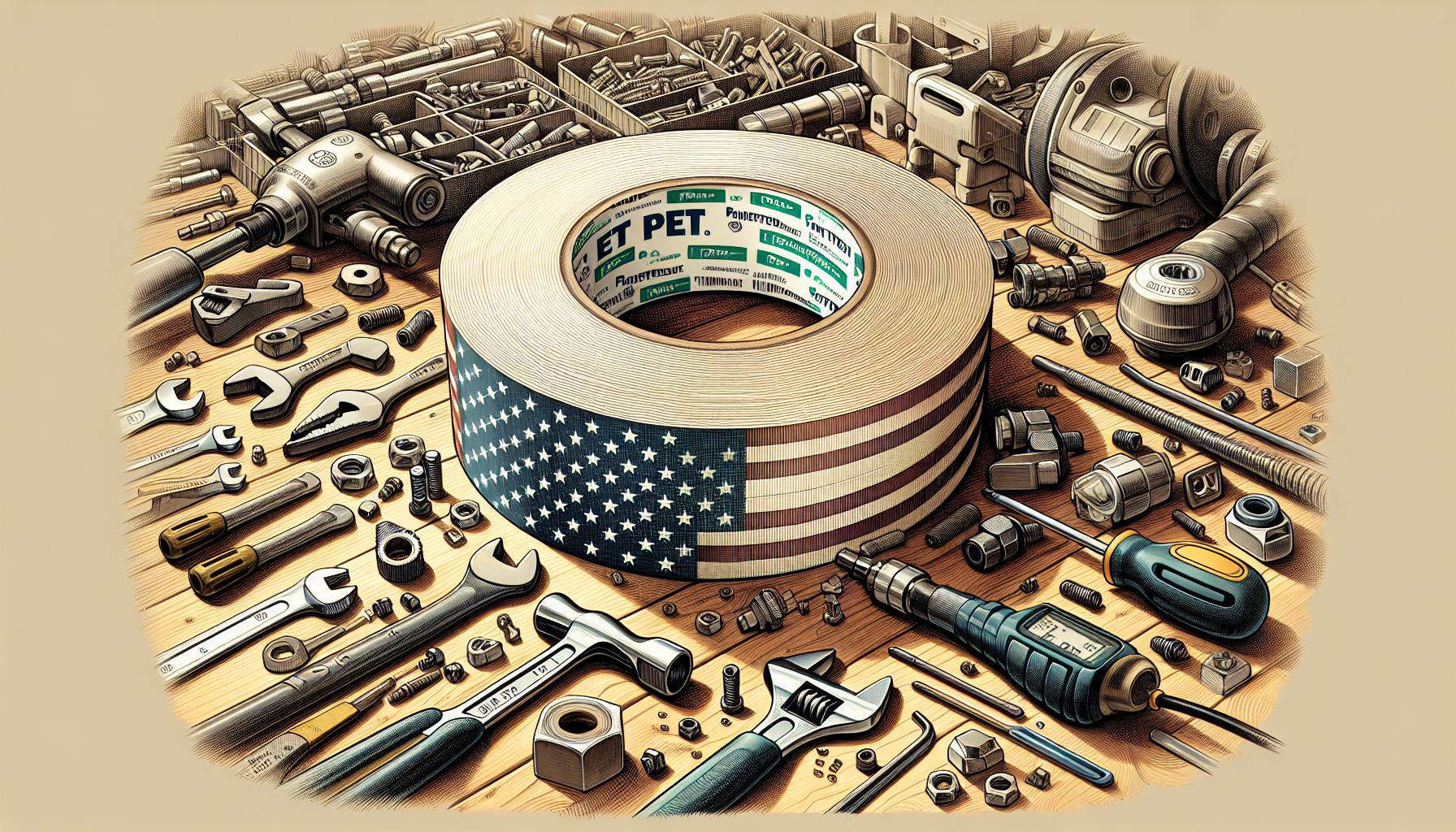When it comes to versatile and durable materials, PET tape stands out as a go-to solution in many industries. You might not realize it, but this high-performance tape plays a crucial role in everything from electronics to packaging. Its unique properties make it an essential tool for both professional and everyday applications.
I’ve always been fascinated by how PET tape combines strength, flexibility, and resistance to heat or chemicals. It’s made from polyethylene terephthalate, a material known for its reliability and adaptability. Whether you’re dealing with electrical insulation or looking for a strong adhesive, PET tape is designed to deliver.
Understanding what makes this tape so effective can help you choose the right product for your needs. Let’s dive into what PET tape is and why it’s become a staple in so many industries.
What Is PET Tape?
PET tape, made from polyethylene terephthalate, is a pressure-sensitive adhesive tape known for its durability and versatility. It features a strong backing material combined with an adhesive layer, making it suitable for demanding applications in various industries.
The tape’s resistance to heat, chemicals, and abrasion ensures reliability in high-performance settings. It retains its structural integrity under temperatures ranging from -70°F to 300°F, making it ideal for applications like electronic insulation and industrial masking.
PET tape offers precise application due to its thin and flexible design. Common uses include securing components in electronic devices, protecting surfaces during painting, and sealing packaging in retail.
Key Features Of PET Tape

PET tape stands out for its unique properties that make it essential across various industries. Its performance is driven by its composition and advanced design.
Durability And Strength
PET tape offers exceptional durability and tensile strength. It resists tearing, cracking, and punctures even under stress, enabling reliable use in demanding applications like electronics and manufacturing. Its strong adhesive bond ensures secure placement on surfaces like plastic, metal, or glass.
Temperature Resistance
This tape retains its integrity across a wide temperature range, from -70°F to 300°F. It withstands prolonged exposure to heat without melting or losing adhesion, making it suitable for high-heat environments in soldering or industrial curing processes.
Versatility In Applications
PET tape adapts to diverse tasks due to its properties. It’s used in masking during painting, protecting surfaces in thermal processes, and sealing electronic components. Industries like automotive and aerospace benefit from its flexibility and adaptability for specific needs.
Types Of PET Tape

PET tape comes in different types, each designed to fulfill specific applications. The two primary categories are single-sided and double-sided PET tape.
Single-Sided PET Tape
Single-sided PET tape includes an adhesive layer on one side, backed by a PET film for reinforcement. This type of tape is widely used in applications where sealing, masking, or surface protection is needed. For example, it prevents damage to surfaces during automotive painting or serves as an insulation layer in electronic circuits. Its resistance to heat, chemicals, and abrasion ensures durability in demanding conditions.
Double-Sided PET Tape
Double-sided PET tape features adhesive layers on both sides, allowing for bonding between two surfaces. It’s commonly used in industries such as packaging, construction, and electronics. For instance, it provides a strong bond for mounting nameplates or sealing components in displays. The PET backing enhances its tensile strength, making it suitable for high-stress applications.
Applications Of PET Tape

PET tape’s adaptability and high-performance properties make it suitable for diverse applications. Its durability, chemical resistance, and temperature tolerance meet the standards of multiple industries.
Industrial Uses
Industries rely on PET tape for demanding tasks requiring strength and reliability. For example, it’s used in the automotive sector for masking during painting and thermal insulation. In aerospace, it helps with component bonding due to its lightweight and high tensile strength. Manufacturing processes also utilize it for splicing and holding tools under extreme heat.
Electrical And Electronic Applications
PET tape is integral to electrical insulation and component protection. It serves as a reliable choice for wrapping cables, covering circuit boards, and insulating battery cells in EVs. Its heat resistance and chemical stability make it essential during soldering or protecting sensitive electronics, such as printed circuit boards (PCBs) in smartphones.
Packaging And Labeling
Packagers opt for PET tape to seal and secure items due to its strong adhesive bond. It works effectively on plastic, glass, and metal surfaces. In retail, it’s employed for tamper-resistant packaging and for attaching durable labels. Its clear variant is frequently used where aesthetics matter, such as product labeling and ensuring barcode visibility.
Household Uses
PET tape finds utility in everyday household purposes. Its durability allows residents to repair items, such as sealing broken surfaces or securing loose wires. Some choose it for temporary fixes, surface protection during home painting, or reinforcing weak packaging before shipping goods. Its multi-purpose functionality ensures practicality at home.
Benefits Of Using PET Tape

PET tape offers a range of advantages, making it indispensable across industries. Its unique properties cater to performance, cost, and environmental considerations.
Eco-Friendly Properties
PET tape stands out for its environmental benefits. Made from recyclable polyethylene terephthalate, it minimizes waste in disposal and offers a sustainable option for industries. PET’s durability reduces the frequency of replacements, which decreases material consumption. Its non-toxic composition adds to its suitability for environmentally conscious applications.
Cost-Effectiveness
PET tape provides long-term cost savings due to its durability and resistance to wear. Its ability to maintain performance in extreme conditions, such as high temperatures or exposure to chemicals, reduces maintenance and replacement expenses. In packaging and electronics, the tape’s efficiency in bonding ensures minimized material wastage and enhanced operational stability.
High Efficiency
PET tape guarantees high-performance results by excelling in demanding tasks. Its strong adhesive ensures secure attachment to various surfaces, including metal, glass, and plastic. In industrial and electronic environments, PET tape optimizes processes like masking during painting, cable wrapping, or mounting components. Its consistent structural integrity under challenging conditions saves time and improves productivity.
Conclusion
PET tape stands out as a reliable and versatile solution for countless applications across industries. Its unique combination of strength, durability, and adaptability makes it an essential material for demanding environments. Whether it’s securing components, protecting surfaces, or enhancing efficiency, PET tape continues to prove its value.
Understanding its properties and uses ensures you can make informed decisions when selecting the right tape for your needs. From industrial settings to everyday tasks, PET tape offers a dependable and sustainable option that delivers long-term performance.
Frequently Asked Questions
What is PET tape made of?
PET tape is made from polyethylene terephthalate, a strong and durable material combined with a pressure-sensitive adhesive layer. This composition gives it excellent resistance to heat, chemicals, and abrasion, making it suitable for various demanding applications.
What are the main uses of PET tape?
PET tape is used in industries such as electronics, packaging, automotive, and aerospace. Common applications include securing electronic components, masking surfaces during painting, wrapping cables, sealing packaging, and bonding materials in high-performance environments.
Is PET tape heat-resistant?
Yes, PET tape is highly heat-resistant, capable of withstanding temperatures ranging from -70°F to 300°F. This makes it ideal for use in high-heat applications, such as industrial curing and soldering processes.
What are the types of PET tape?
PET tape comes in two main types: single-sided and double-sided. Single-sided tape is used for sealing, masking, and surface protection, while double-sided tape is used for bonding two surfaces together, such as in mounting or construction applications.
Why is PET tape considered eco-friendly?
PET tape is eco-friendly because it is made from recyclable polyethylene terephthalate. Its durability reduces waste by minimizing the need for frequent replacements, and its recyclable nature contributes to sustainable practices.
Can PET tape adhere to different surfaces?
Yes, PET tape has a strong adhesive bond that works well on various surfaces, including plastic, metal, glass, and even rough surfaces. This versatility makes it useful across numerous industries and applications.
How does PET tape benefit the electronics industry?
In the electronics industry, PET tape is used for insulation, cable wrapping, and protecting components in circuit boards. Its durability and heat resistance ensure reliable performance in these high-stress applications.
What makes PET tape cost-effective?
PET tape’s durability reduces the need for frequent replacements, lowering material consumption and maintenance costs. Its strong adhesive and ability to withstand extreme conditions contribute to improved productivity and long-term savings.
Can PET tape be used for household purposes?
Yes, PET tape is versatile enough for household use. It can be used for repairing items, surface protection during DIY projects, and even masking surfaces during painting tasks.
How does PET tape perform in industrial settings?
PET tape is highly reliable in industrial environments due to its strength, heat resistance, and chemical resistance. It is commonly used for masking, bonding, and sealing in demanding industries like automotive and aerospace.